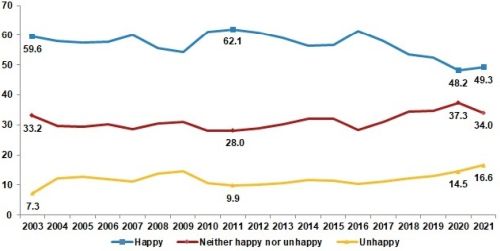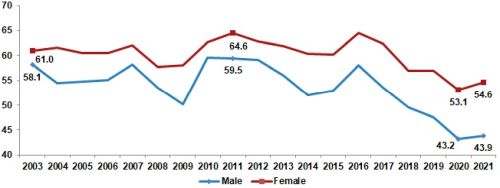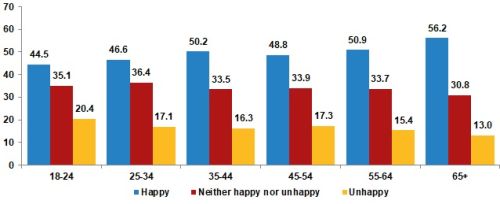* Photo: Anadolu Agency (AA)
Click to read the article in Turkish
The Turkish Statistical Institute (TurkStat), the state agency responsible for sharing official statistics on Turkey, published the results of its "Life Satisfaction Survey" for 2021 today (February 17).
According to TurkStat, last year, 49.3 percent of society was happy. While 48.2 percent of individuals aged 18 and over mentioned that they were happy in 2020, the proportion was 49.3 percent in 2021.
The proportion of individuals who mentioned that they were unhappy was 14.5 percent in 2020 and 16.6 percent in 2021.
According to TurkStat data over the years, the rate of unhappy people was 7.3 percent in Turkey in 2003, a year after the Justice and Development Party (AKP) came to power for the first time. In 2021, the rate of unhappy people increased to 16.6 percent by doubling in 18 years.

Other highlights from the survey results are as follows:
Women are happier
While the rate of men who mentioned that they were happy was 43.2 percent in 2020, it was 43.9 percent in 2021. The rate of happiness for women was 53.1 percent in 2020, it was 54.6 in 2021.

The proportion of individuals who stated themselves as happy by sex (%), 2003-2021
Married ones happier than unmarried
It was seen in the survey results that married individuals were happier than unmarried individuals. While the proportion of married individuals who mentioned that they were happy was 54.0 percent, this proportion was 40.1 percent for unmarried ones in 2021.
According to survey results, when the level of happiness of married individuals was analyzed by sex, it was seen that 48.9 percent of married men and 58.8 percent of married women were happy.
The happiest ones: The age group of 65 and over
When the level of happiness was analyzed by age groups, the highest level of happiness was at the 65 and over age group with 57.7 percent in 2020 and 56.2 percent in 2021. The lowest level of happiness was witnessed at the 35-44 age group with 45.4 percent in 2020 and it was seen at the 18-24 age group with 44.5 percent in 2021.

* Level of happiness by age group (%), 2021
Individuals who didn't complete school were happier
When the level of happiness was analyzed by level of education, it was seen that the highest level of happiness was seen at individuals who did not complete school with 54.4 percent in 2021.
It was followed by individuals who were primary school graduates with 51.4 percent, high school and equivalent graduates with 47.8 percent, higher education graduates with 47.6 percent, primary education or junior high school graduates with 45.7 percent respectively.
Families were the source of happiness
When the persons as source of happiness were analyzed in 2021; while the proportion of individuals who mentioned that their families made them happiest was 67.6 percent, it was followed by children with 16.8 percent, spouse with 4.1 percent, parents with 4.0 percent, themselves with 4.0 percent and grandchildren with 2.1 percent, respectively.
Being healthy made individuals happiest
When the values as source of happiness were analyzed in 2021; while the proportion of individuals who mentioned that their health made them happiest was 69 percent, it was followed by love with 14.3 percent, success with 8.9 percent, money with 5.1 percent and job with 2.3 percent.
Level of satisfaction from public services
When the level of satisfaction from public services was analyzed in 2021; while the proportion of ones who stated that they were satisfied from the public security services was 73.8 percent, it was followed by satisfaction levels from transportation services with 69.8 percent, health services with 68.1 percent, services of Social Security Institution with 59.1 percent, education services with 55.7 percent and judicial services with 54.8 percent.
6 out of 10 people hopeful about their future
The proportion of individuals who mentioned that they were hopeful about their own future was 60.7 percent in 2021. While the proportion of men who were hopeful about their own future was 59.1 percent, this proportion for women was 62.4 percent. (HA/SD)






